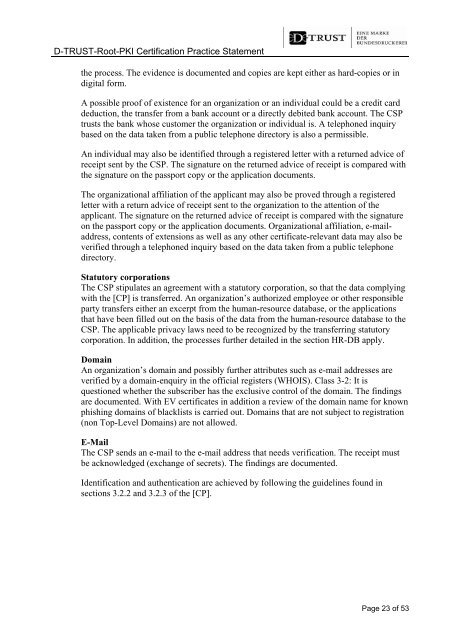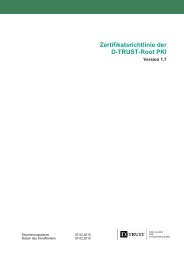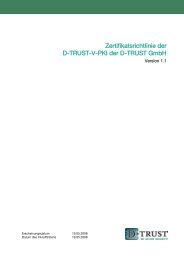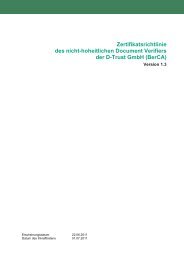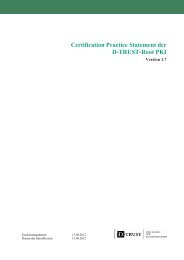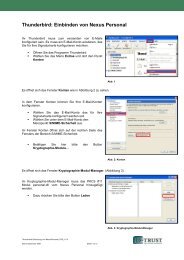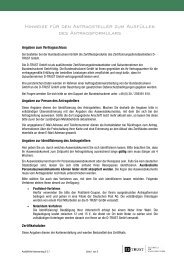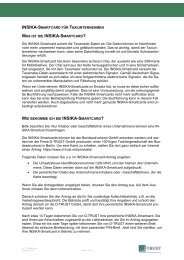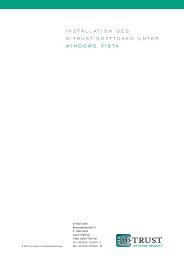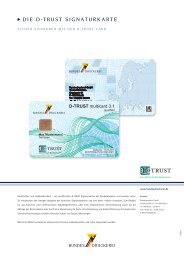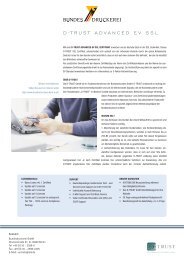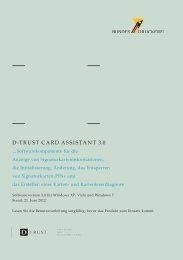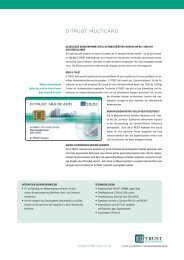D-TRUST-Root PKI Certification Practice Statement
D-TRUST-Root PKI Certification Practice Statement
D-TRUST-Root PKI Certification Practice Statement
You also want an ePaper? Increase the reach of your titles
YUMPU automatically turns print PDFs into web optimized ePapers that Google loves.
D-<strong>TRUST</strong>-<strong>Root</strong>-<strong>PKI</strong> <strong>Certification</strong> <strong>Practice</strong> <strong>Statement</strong><br />
the process. The evidence is documented and copies are kept either as hard-copies or in<br />
digital form.<br />
A possible proof of existence<br />
for an organization or an individual could be a credit card<br />
deduction, the transfer from a bank account or a directly debited bank account. The CSP<br />
trusts the bank whose customer the organization or individual is. A telephoned inquiry<br />
based on the data taken from a public telephone directory is also a permissible.<br />
An individual may also be identified through a registered letter with a returned advice of<br />
receipt sent by the CSP. The signature on the returned advice of receipt is compared with<br />
the signature on the passport copy or the application documents.<br />
The organizational affiliation of the applicant may also be proved through a registered<br />
letter with a return advice of receipt sent to the organization to the attention of the<br />
applicant. The signature on the returned advice of receipt is compared with the signature<br />
on the passport copy or the application documents. Organizational affiliation, e-mailaddress,<br />
contents of extensions as well as any other certificate-relevant<br />
data may also be<br />
verified through a telephoned inquiry based on the data taken from a public telephone<br />
directory.<br />
Statutory corporations<br />
The CSP stipulates an agreement with a statutory corporation, so that the data complying<br />
with the [CP] is transferred. An organization’s authorized employee or other responsible<br />
party transfers either an excerpt from the human-resource database, or the applications<br />
that have been<br />
filled out on the basis of the data from the human-resource database to the<br />
CSP. The applicable privacy laws need to be recognized by the transferring statutory<br />
corporation. In addition, the<br />
processes further detailed in the section HR-DB apply.<br />
Domain<br />
An organization’s domain and possibly further attributes such as e-mail addresses are<br />
verified by a domain-enquiry in the official registers (WHOIS). Class 3-2: It is<br />
questioned whether the subscriber has the exclusive control of the domain. The findings<br />
are documented. With EV certificates in addition a review of the domain name for known<br />
phishing domains of blacklists is carried out. Domains that are not subject to registration<br />
(non Top-Level<br />
Domains) are not allowed.<br />
E-Mail<br />
The CSP sends an e-mail to the e-mail address that needs verification. The receipt must<br />
be acknowledged (exchange of secrets). The findings are documented.<br />
Identification and authentication are achieved<br />
by following the guidelines found in<br />
sections 3.2.2 and 3.2.3 of the [CP].<br />
Page 23 of 53


